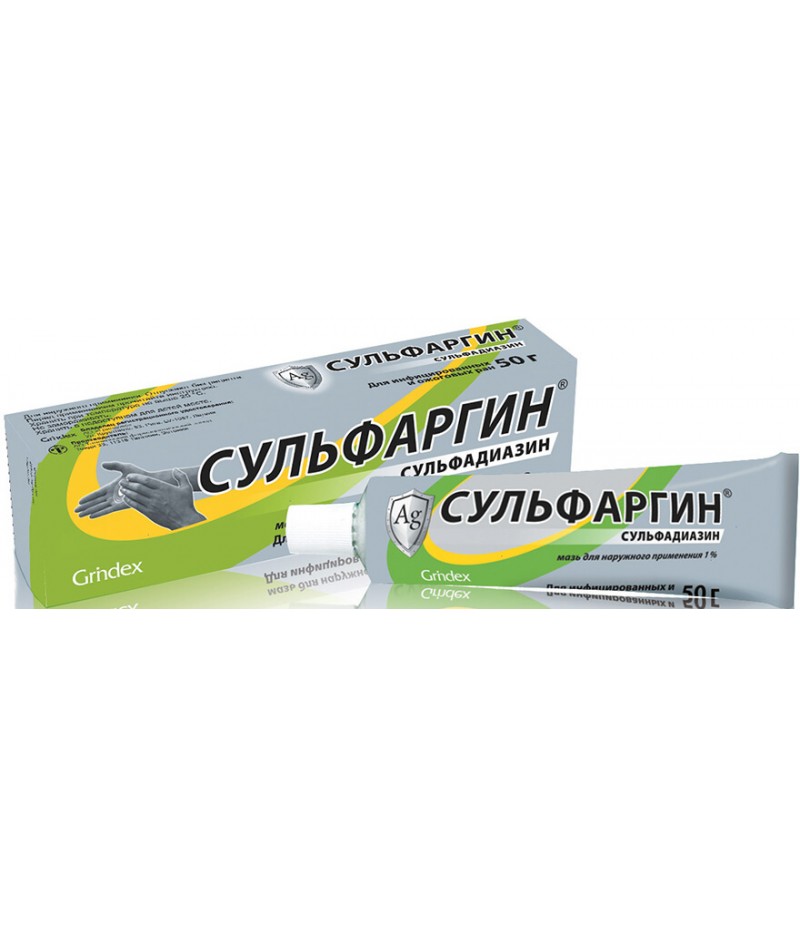Sulfargin ointment 50gr
- $18.45
- 3 or more $18.29
- Availability:In Stock
Sulfargin user manualYou can buy Sulfargin on this pageDosage form, compositionOintment Sulfargin has white color, homogeneous character and a specific smell. The main active ingredient of the drug is silver sulfadiazine. Its cont..
Tags: ointment
Sulfargin user manual
You can buy Sulfargin on this page
Dosage form, composition
Ointment Sulfargin has white color, homogeneous character and a specific smell. The main active ingredient of the drug is silver sulfadiazine. Its content in 1 g of ointment is 10 mg (1% ointment). It also includes additional components, which include:
Methyl parahydroxybenzoate.
Propylene glycol.
Propylparahydroxybenzoate.
Glycerol monostearate.
Cetyl stearyl alcohol.
Vaseline oil.
Purified water.
Propylene glycol.
Ointment Sulfargin contained in a tube in the amount of 50 g. A cardboard box contains one tube with ointment, as well as instructions for use.
Drug action
The main active component of the ointment Sulfargin refers to sulfonamides. It blocks the synthesis of folic acid in violation of the synthesis of purine bases, which are a structural component of genes, and also releases silver ions, which lead to denaturation of proteinaceous compounds of a bacterial cell and its death. Due to this effect bactericidal therapeutic effect is realized. The drug is active against most gram-positive and gram-negative bacteria and leads to their death with proper use of the drug.
After applying the Sulfargin ointment on the skin, the active ingredient is practically not absorbed into the systemic circulation.
Indications for use
Sulfargin ointment is used for several indications for the treatment of purulent-necrotic pathology (trophic ulcers, pressure sores, burns accompanied by mild exudation) in several situations:
Treatment of fresh burn surface of the skin.
Treatment of wounds and burns of I and III degrees at stages 2 and 3 of the pathological process.
Treatment of burns and wounds in the first stage of the pathological process.
Also, the drug is used for complex treatment of bedsores, developing in patients during prolonged immobilization, non-healing wounds, including their localization in the stump of an amputated limb, as well as in trophic ulcers.
Contraindications for Sulfargin
The medical use of Sulfargin ointment is contraindicated in certain pathological and physiological conditions of the patient’s body, which include:
Pregnancy at any stage of the course.
Breastfeeding period (lactation).
Hypersensitivity to sulfonamides group funds, including those transferred in the past.
Individual intolerance to any of the components of this drug.
Age of the child up to 1 year.
Significant deficiency of the enzyme glucose-6-dehydrogenase.
It is not recommended to use the drug for the treatment of deep burn surfaces, as well as purulent wounds, accompanied by severe exudation. Before using this medication, it is important to ensure that there are no contraindications.
Method of use, dose
Ointment Sulfargin intended for external local use. Primary surgical treatment of a wound or burn surface with removal of necrotic masses and pus is necessarily preliminarily performed. Ointment is applied to the affected surface with a thin layer of about 2-4 mm, a bandage is applied on top or the wound is left open (open method of therapy). The procedure is repeated 1-2 times a day or less (every other day), which depends on the severity of the pathological process and its area on the skin. The maximum single dose should not exceed 300 mg. The average duration of the course of therapy with Sulfargin ointment varies within 3 weeks.
Side effects of Sulfargin
In most cases, during the application of Sulfargin ointment, local negative pathological reactions may develop in the form of short-term burning, redness of the skin (hyperemia). With prolonged use of the drug over a wide area of the skin, systemic adverse effects are possible, accompanied by dry mouth, nausea with occasional vomiting, headache, changes in the functional state of peripheral blood, and allergic reactions. In this case, the dosage of the drug is reduced or its use is stopped.
Special recommendations
Before starting the use of Sulfargin ointment, the doctor must pay attention to a few special recommendations, which include:
With long-term use of a significant amount of ointment, periodic laboratory monitoring of the functional state of the blood, liver and kidneys is mandatory.
It is recommended to increase the drinking regime with an increase in fluid intake in the body against the background of the use of this medication.
If an ointment is used to apply to large areas of the skin, systemic absorption of silver ions with the development of various toxic or allergic reactions is possible.
The drug is not intended for application to mucous membranes.
In case of accidental contact of ointment with eyes, wash them with a sufficient volume of flow-through liquid.
The active component of the drug does not directly affect the state of the nervous system.
In pharmacies, Sulfargin ointment is dispensed without a doctor's prescription. If you have any doubts about the use of this medication, it is recommended to consult with a medical specialist.
Overdose
In the case of a significant excess of the recommended therapeutic dose of Sulfargin ointment (application of ointment to large areas of skin in an amount of more than 300 g), systemic pathological adverse reactions may develop. In this case, symptomatic therapy and forced diuresis are carried out for the rapid removal of the drug from the blood in the hospital.
Storage rules
Shelf life Sulfargin ointment is 2 years. It is important to keep it in the whole package, in a dark, dry place inaccessible to children at an air temperature not higher than + 25 ° C.
Terms of sell
You can buy Sulfargin without a prescription.

